[Eng-Esp] Hemiptera of the genus Antiteuchus // Hemípteros del género Antiteuchus
Greetings dear friends of the Hive platform, welcome back to my blog dedicated to the study and dissemination of material related to the world of arthropods. In this text you will appreciate a member of the family Pentatomidae and the genus Antiteuchus, so you are cordially invited to learn relevant data about this type of insects.
Saludos estimados amigos de la plataforma Hive, sean todos bienvenidos nuevamente a mi blog dedicado al estudio y a la difusión de material referente al mundo de los artrópodos. En el presente texto se apreciará a un miembro de la familia Pentatomidae y del género Antiteuchus, por lo que están cordialmente invitados a conocer datos relevantes sobre este tipo de insectos.
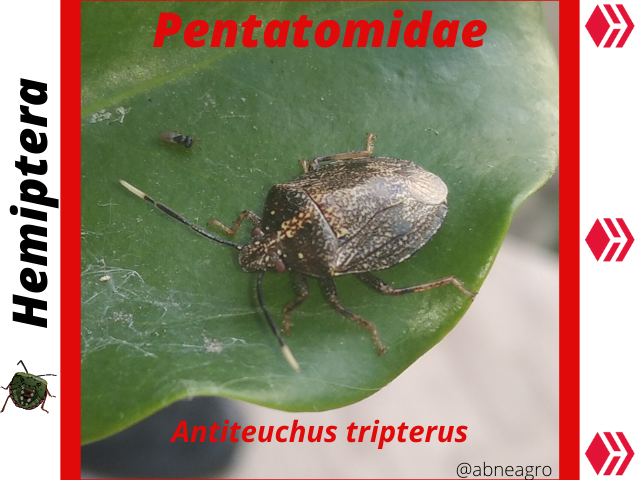
The family Pentatomidae is one of the most numerous and widely studied groups at entomological level, its species are distributed throughout the world and are found in large quantities in those ecosystems that have been modified by man for their benefit (agroecosystems). This type of insects are well known for the repugnant odor that they are able to expel from their bodies when they feel threatened, an aspect that is an active part of their defense mechanism against certain external factors.
This family of the order Hemiptera has more than 5,000 species distributed in an estimated 10 subfamilies, most of which are considered of agricultural interest due to their feeding habits, since almost all species are phytophagous and can feed on a wide variety of plant organisms, becoming a frequent problem in agriculture worldwide, especially in the countries of the American continent. It is also important to note that the only subfamily that does not feed on plants is Asopinae, which is composed of stink bugs that are predators of different insects, functioning as natural regulators of arthropod populations present in terrestrial ecosystems.
La familia Pentatomidae es uno de los grupos más numerosos y ampliamente estudiadas a nivel entomológico, sus especies están distribuidas por todo el mundo y se encuentran en grandes cantidades en aquellos ecosistemas que han sido modificados por el hombre para su beneficio (agroecosistemas). Este tipo de insectos son muy conocidos por el repugnante olor que son capaces de expulsar de sus cuerpos cuando se sienten amenazados, aspecto que forma parte activa de su mecanismo de defensa ante determinados factores externos.
Esta familia del orden Hemiptera posee más de 5.000 especies distribuidas en un estimado de 10 subfamilias, de las cuales la mayoría se consideran de interés agrícola debido a sus hábitos alimenticios, ya que casi todas las especies son fitófagas y se pueden alimentar de una amplia variedad de organismos vegetales, volviéndose un problema frecuente dentro de la agricultura a nivel mundial, sobre todo en los países del continente Americano. De igual manera, es importante acotar que, la única subfamilia que no tiene como fuente de alimento a las plantas es la Asopinae, la cual está compuesta por chinches apestosos que son depredadores de diferentes insectos, funcionando estos como reguladores naturales de las poblaciones de artrópodos presentes en los ecosistemas terrestres.
.png)
Within this large family is the subfamily Discocephalinae, and forming part of this taxon is the genus Antiteuchus, which consists of an estimated 10 species classified so far, as there are some of these insects that are still under discussion. One of the most recognized specimens of this genus is Antiteuchus tripterus, a species that can be found in Central America and southern America, where it is usually a problem in plantations of Theobroma cacao (cocoa), Persea americana (avocado), Vitis vinifera (grapevine), among other plant species.
Dentro de esta numerosa familia se ubica la subfamilia Discocephalinae, y formando parte de este taxón se encuentra el género Antiteuchus, el cual está conformado por un estimado de 10 especies clasificadas hasta el momento, ya que existen algunos de estos insectos que aún se encuentran en discusión. Uno de los ejemplares más reconocidos de este género es el Antiteuchus tripterus, especie que puede encontrarse en centroamerica y en el sur del continente americano; en donde suele ser un problema en plantaciones de Theobroma cacao (cacao), Persea americana (aguacate), Vitis vinífera (vid), entre otras especies vegetales.
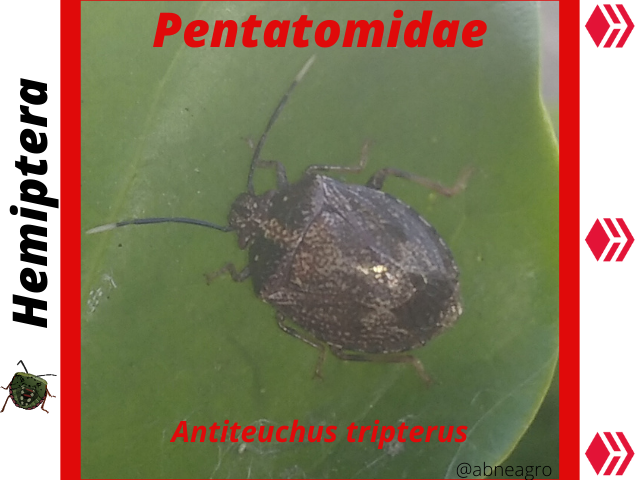.png)
The damage they cause to plant organisms is generated by their mouthparts, which are designed to perforate plant tissues and extract their fluids. Likewise, the real problem comes when the populations of these insects are very high, because as they feed they progressively weaken the host plants, causing poor development and in the worst case the death of the plant, in addition each wound they make on plant tissues can become a gateway for many harmful microorganisms, generating large economic losses for agricultural producers.
El daño que provocan en los organismos vegetales es generado por su aparato bucal, el cual está diseñado para perforar los tejidos de las plantas y extraer sus fluidos. Asimismo, el problema real viene dado cuando las poblaciones de estos insectos son muy altas, ya que a medida que se alimentan van debilitando de manera progresiva a las plantas hospederas, generando esto mal desarrollo y en el peor de los casos la muerte de la planta, además cada herida que realizan sobre los tejidos vegetales se puede convertir en una puerta de entrada para muchos microorganismos nocivos, generando todo esto grandes perdidas económicas para los productores agrícolas.
.png)
Among its most outstanding morphological characteristics we find a solid armor of chitin and other proteins that protects all the soft parts of its body, highlighting an elongated piece that is located in the center of its thoracic region and also covers part of its abdomen, this piece is called scutellum. On the other hand, its body is rounded and is divided into the 3 characteristic tagmas that divide the body of insects (head, thorax and abdomen), aspects that must always be taken into account to differentiate them from other arthropods such as arachnids, crustaceans and myriapods.
These insects are flying organisms, so in the absence of food they can migrate to other areas, where if environmental conditions are optimal, they can reproduce and generate new offspring. As for the wings of members of the genus Antiteuchus, it is observed that they do not differ much from other stink bugs of the family Pentatomidae, retaining 2 pairs of wings of which the first pair is partially hardened (hemielliters), having the main function of providing protection to the hind wings that are completely membranous and also, these give stability to the insect during flight.
Entre sus características morfológicas más destacables nos encontramos con una sólida coraza de quitina y otras proteínas que protege todas las partes blandas de su cuerpo, destacando una pieza alargada que se encuentra en la zona media de su región torácica y que también cubre parte de su abdomen, esta pieza se denomina escutelo. Por otro lado, su cuerpo es redondeado y se divide en los 3 característicos tagmas que dividen el cuerpo de los insectos (cabeza, tórax y abdomen), aspectos que siempre se deben de tener en cuenta para diferenciarlos de otros artrópodos tales como arácnidos, crustáceos y miriápodos.
Estos insectos son organismos voladores, por lo que ante la falta de alimento pueden emigrar a otras zonas, en donde si las condiciones ambientales son óptimas, pueden reproducirse y generar nueva descendencia. En lo que respecta a las alas de los miembros del género Antiteuchus, se destaca que no son muy diferentes de las demás chinches apestosas de la familia Pentatomidae, conservando 2 pares de alas de los cuales el primer par esta parcialmente endurecido (hemiélitros), teniendo la principal función de dar protección a las alas posteriores las cuales son completamente membranosas y además, éstas otorgan estabilidad al insecto durante el vuelo.
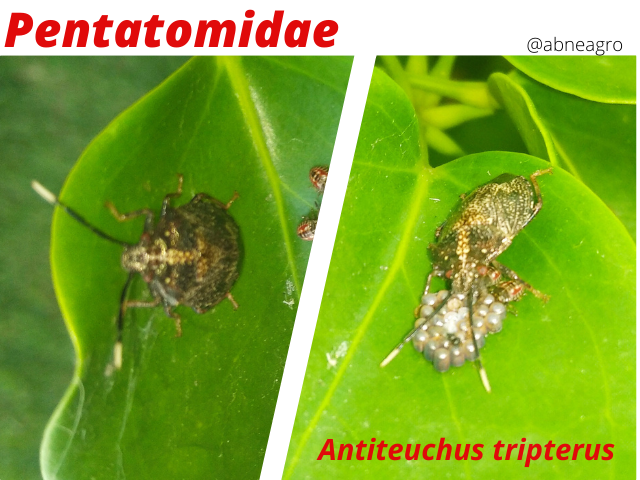.png)
The predominant color of the species Antiteuchus tripterus is between brown and black, having some parts of its body darker than others, this characteristic helps to differentiate the sexes, since males are black, while females have the variants in the mentioned colors.
The specimen in the photograph corresponds to a female Antiteuchus tripterus, the identification of this insect was not an easy task due to the large number of similar specimens that can be found within the large family Pentatomidae, it is often necessary to have a second opinion of someone with more experience in hemiptera to avoid mistakes when identifying.
El color predominante de la especie Antiteuchus tripterus se sitúa entre el marrón y el negro, teniendo algunas partes de su cuerpo más oscuras que otras, esta característica ayuda a diferenciar los sexos, ya que los machos son negros, mientras que las hembras tienen las variantes en los colores mencionados.
El ejemplar de la fotografía corresponde a una hembra de Antiteuchus tripterus, la identificación de este insecto no fue una tarea sencilla debido al gran número de especímenes similares que se pueden encontrar dentro de la extensa familia Pentatomidae, muchas veces es necesario tener una segunda opinión de alguien con más experiencia en hemípteros para evitar errores a la hora de identificar.
.png)
One of the most remarkable aspects of this type of insects is the care they give to their eggs. In the photographs you can see a female providing protection to her young, this type of behavior helps to ensure the life of the nymphs when they hatch from eggs, thus many of them manage to develop in order to continue with the perpetuation of the species. Thanks to this, these insects are very successful in increasing their populations and are also very resistant to chemicals.
Uno de los aspectos más destacables de este tipo de insecto es el cuidado que le dan a sus huevos. En las fotografías se puede apreciar a una hembra proporcionándoles protección a sus crías, este tipo de comportamiento ayuda a garantizar la vida de las ninfas cuando emergen de los huevos, de esta manera muchas de ellas lograrán desarrollarse para luego continuar con la perpetuación de la especie. Gracias a lo anteriormente mencionado, estos insectos tienen mucho éxito en lo que se refiere al aumento de sus poblaciones, además son muy resistentes a los productos químicos.
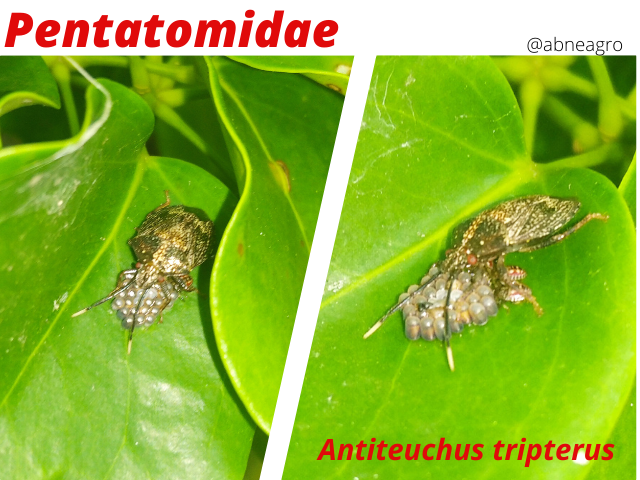.png)
When this insect sees that its eggs are in danger, it enters into a state of alert, so it may seek to attack the potential aggressor, not having a stinger or jaws, this small specimen uses intimidation and the emission of a strong-smelling substance to repel threats, this liquid can irritate our skin and can be a problem if it somehow reaches our eyes.
Cuando este insecto ve que sus huevos están en peligro entra en estado de alerta, por lo que puede buscar atacar al posible agresor, al no contar con aguijón o mandíbulas, este pequeño espécimen utiliza la intimidación y la emisión de una sustancia de fuerte olor para repeler a las amenazas, este líquido puede llegar a irritar nuestra piel y puede ser un problema si de alguna manera llega a nuestros ojos.
.png)
This photographic material shows part of the life cycle of an Antiteuchus tripterus. These insects do not have a larval stage and do not make chrysalises to develop, so from the moment they hatch from the egg they are nymphs. The nymphs progressively molt their exoskeletons, with each cuticle molt they increase in size and their coloration changes. Once a nymph passes to the adult stage, wings and reproductive organs develop.
As a curious fact, you have probably seen in some of the photographs a small black wasp, this you can see in the initial photo and in the first image where the eggs are seen. This small member of the order Hymenoptera is an insect that parasitizes the eggs of some arthropods, among these are those of the family Pentatomidae; the wasp introduces its eggs inside the eggs of other insects, so the larvae feed and emerge as adults. This tiny insect is scientifically known as Phanuropsis semiflaviventris, being a member of the Scelionidae family and is widely used for the biological control of stink bugs.
En este material fotográfico se puede apreciar parte del ciclo de vida de una Antiteuchus tripterus. Estos insectos no cuentan con un estado de larva y tampoco realizan crisálidas para desarrollarse, por lo que desde que salen del huevo son ninfas. Las ninfas van mudando de manera progresiva sus exoesqueletos, con cada muda de cutícula aumentan de tamaño y su coloración va cambiando, una vez que una ninfa pasa al estado adulto se desarrollan las alas y los órganos reproductores.
Como dato curioso, probablemente hayas visto en algunas de las fotografías una pequeña avispa negra, esta puedes verla en la foto inicial y en la primera imagen en donde se ven los huevos. Este pequeño miembro del orden Himenoptera es un insecto que parásita los huevos de algunos artrópodos, entre estos están los de la familia Pentatomidae; la avispa introduce sus huevos dentro de los huevos de otros insectos, por lo que las larvas se alimentan y emergen siendo adultos. Este diminuto insecto se conoce a nivel científico bajo el nombre de Phanuropsis semiflaviventris, siendo un miembro de la familia Scelionidae y es ampliamente usado para el control biológico de chinches apestosas.
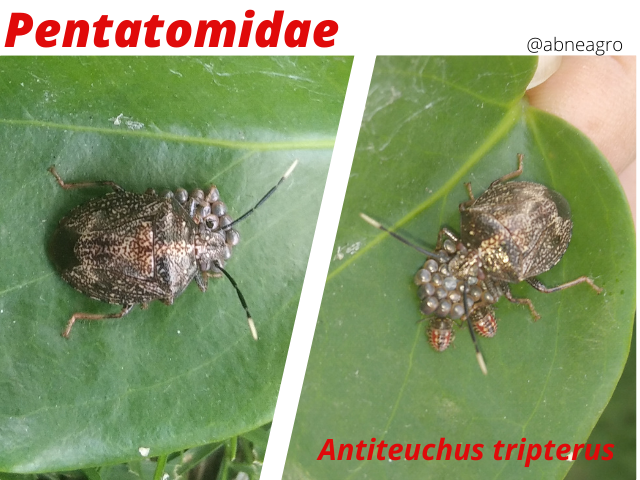.png)
Despite being of a well-known family in the world, all species of the genus Antiteuchus are still not very popular; clearly this is due to their inconspicuous colors and their limited presence in many countries, for this reason they are displaced in this regard by other members of the family Pentatomidae, however, currently it has been seen that their populations are increasing and the damage they generate in crops is increasingly noticeable, so that, some countries are already including them in lists of harmful insects for food production.
A pesar de ser de una familia muy conocida en el mundo, todas las especies del género Antiteuchus siguen sin ser muy populares; claramente esto es debido a sus colores poco llamativos y su limitada presencia en muchos países, por esta razón se ven desplazadas en este sentido por otros miembros de la familia Pentatomidae, sin embargo, actualmente se ha visto que sus poblaciones están en aumento y el daño que generan en los cultivos se hace notar cada vez más, de manera que, algunos países ya los están incluyendo en listas de insectos perjudiciales para la producción de alimentos.

The shared material is created so that people interested in the world of arthropods can learn more about these invertebrates, likewise, there are species that can only be seen in a certain number of countries (endemic), so the dissemination of this type of content helps them to be appreciated in different parts of the world. The Hive platform and the communities of scientific topics that make active life in the blockchain, serve as tools or digital media in which you can expand the knowledge about these members of the animal kingdom in a didactic and educational way. Thank you very much for reading!
El material compartido es creado con la finalidad de que personas interesadas en el mundo de los artrópodos puedan conocer más acerca de estos invertebrados, de igual manera, hay especies que solo se pueden apreciar en un determinado número de países (endémicas), por lo que la difusión de este tipo de contenidos contribuye a que puedan ser apreciadas en diferentes partes del mundo. La plataforma Hive y las comunidades de temáticas científicas que hacen vida activa en la blockchain, sirven como herramientas o medios digitales en los que se puede expandir el conocimiento acerca de estos miembros del reino animal de una manera didáctica y educativa. ¡Muchas gracias por leer!

All photos presented in this publication belong to the author @abneagro, the photos were taken with a Redmi 8A mobile device and edited with the Canva application.
Todas las fotografías presentadas en esta publicación pertenecen al autor @abneagro, las fotos fueron realizadas con un dispositivo móvil Redmi 8A y editadas con la aplicación Canva.

Some references:

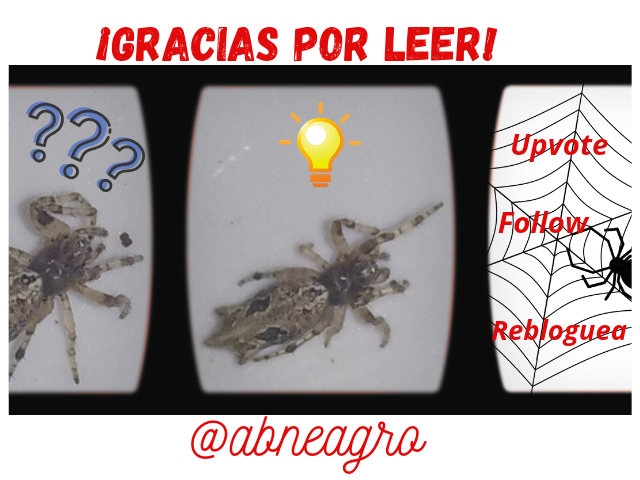
Hola @abneagro... Como siempre una publicación impecable.
Gracias por compartir tus conocimientos en ésta plataforma.
Gracias a ti por apoyar el contenido de mi blog, y a su vez, también te felicito por compartir escritos referentes a un área tan importante e interesante como lo es la física, nos seguimos leyendo, saludos!
Su post ha sido valorado por @ramonycajal
Muchas gracias por el apoyo, saludos!
Thanks for your contribution to the STEMsocial community. Feel free to join us on discord to get to know the rest of us!
Please consider supporting our funding proposal, approving our witness (@stem.witness) or delegating to the @stemsocial account (for some ROI).
Please consider using the STEMsocial app app and including @stemsocial as a beneficiary to get a stronger support.
Thanks for the support!
Puff!! Otra vez llegué tarde jejeje... Pues bueno qué te puedo decir? Solo agradecerte por instruirnos y presentar tan completas publicaciones... Me alegro que seas bien recompensado.. me pregunto, qué usarás como amuleto de buena suerte? 🤔 jajaja. (Para que lo prestes un momento)
Saludos Abner!
Holaaa hoolaaa! Jajaja, muchas gracias por pasarte por mi blog Loourdes, me alegra que también te haya gustado esta publicación, y pues, el amuleto es un secretoo jajaja, te mando un abrazoote!
This post is even more extensively written and presents as your posts before .. really amazing 😍 .. also the scenes that you pictured are really nice and educative .. I love it 🥳
That's right @adalger, the post ended up being a bit longer than my previous posts, however, everything shared in this article was necessary, thanks a lot for the support my friend!
great post as always
We appreciate your work and your post was manually curated by @none! from the DNA team!
Reach us on Discord to learn more about the project!
Thanks for the support!
Congratulations @abneagro! You received a personal badge!
You can view your badges on your board and compare yourself to others in the Ranking
Gracias por el recordatorio, saludos!
De nada @abneagro, es un placer 😊👍